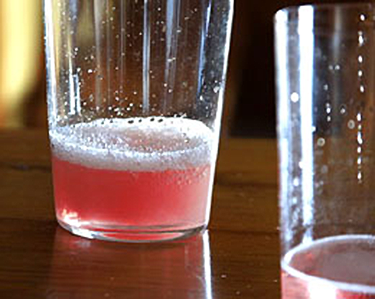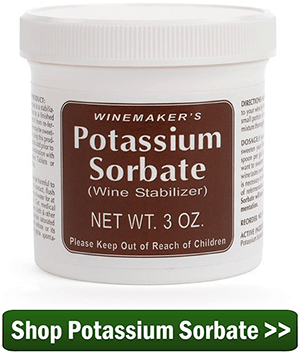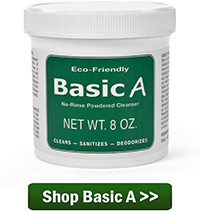 I bottled some blackberry a few months ago. When I opened a bottle today it fizzed over and kept bubbling for a while. What did I do wrong, I followed a wine recipe?
I bottled some blackberry a few months ago. When I opened a bottle today it fizzed over and kept bubbling for a while. What did I do wrong, I followed a wine recipe?
Name: Ed W.
State: FL
—–
Hello Ed,
Sorry to hear that your wine has gotten a little out of control. Let’s see if we can figure out what’s going on. If you find yourself asking, “Why is my homemade wine fizzy,” keep reading.
There are basically two ways a homemade wine can end up fizzy or bubbly. I’ll go over them here:
1. Re-Fermentation:
This is the most common way to get a fizzy wine. When a fermentation stops it usually means that it has finished. That means all the sugars in the wine must have been fermented into alcohol. There are no more sugars to ferment.
But on occasion a fermentation will stop before the sugars are all gone. This is known as a stuck fermentation. This can happen for a number of reasons: wrong fermentation temperature, using distilled water, etc. (see The Top 10 Reasons For Fermentation Failure) For this reason it is important that you check the must with a wine hydrometer to confirm that all the sugars have been fermented before moving on to the next step.
If you continue on with the wine recipe and end up bottling the wine with sugars still in it, then a fermentation could start up within any or all the wine bottles at any time in the future, even months down the road. It is important to remember that even the slightest amount of fermentation can cause a lot of fizzy within the wine.
 The only exception to the above is if you have added potassium sorbate to the wine, also known as wine stabilizer. If you have added this before bottling, then the chance have having a re-fermentation within the wine bottles is greatly diminished. The same holds true if you have sweetened the wine before bottling. You need to add potassium sorbate along with the sugar to eliminate a potential for a re-fermentation within the wine bottle.
The only exception to the above is if you have added potassium sorbate to the wine, also known as wine stabilizer. If you have added this before bottling, then the chance have having a re-fermentation within the wine bottles is greatly diminished. The same holds true if you have sweetened the wine before bottling. You need to add potassium sorbate along with the sugar to eliminate a potential for a re-fermentation within the wine bottle.
2. Bacterial Infection:
This is not as common of a reason for a homemade wine being fizzy as a re-fermentation, but it happens. If the fermenters, stirring spoons, hoses, wine bottles, corks and anything else the wine comes into contact with has not been sufficiently sanitized, then you run the risk of infecting your wine with a bacteria.
There are many excellent sanitizers on the market. We recommend Basic A because it is very safe and simple to use. You should also add sulfites directly to the wine after the fermentation, and again, right before bottling the wine. If you miss killing some bacteria, then adding sulfites such as Campden tablet or sodium metabisulfite to the wine will go a long way towards protecting it.
One thing you have mentioned is that the wine is fizzy instead of bubbly. If the wine has re-fermented, most people would describe it as bubbly and not fizzy. The CO2 bubbles from a fermentation are pretty good size. Fizzy sounds like the bubbles are smaller than that. That is what you would expect to find with a bacterial infection.
 You also said that it fizzed for a long time. This is fairly definitive. When you get a fizzing that bubbles evenly for a period of time, that is also an indicator of a bacterial infection. Carbonation from a re-fermentation is more explosive and short-lived. A bacterial infection is not explosive. Once you open the bottle, it take a few seconds for it to build up a head of steam and get going.
You also said that it fizzed for a long time. This is fairly definitive. When you get a fizzing that bubbles evenly for a period of time, that is also an indicator of a bacterial infection. Carbonation from a re-fermentation is more explosive and short-lived. A bacterial infection is not explosive. Once you open the bottle, it take a few seconds for it to build up a head of steam and get going.
I’m not sure, because I am not there, but I would guess the reason your homemade wine is fizzy is because of a bacterial infection. That being the case, sanitation of equipment and use of sulfites needs to be the focus when making future batches.
Best Wishes,
Ed Kraus
—–
Ed Kraus is a 3rd generation home brewer/winemaker and has been an owner of E. C. Kraus since 1999. He has been helping individuals make better wine and beer for over 25 years.

If you discover a bacterial infection is causing fizzing, can you still drink the wine?
Living in South Georgia we grow muscadine. We decided for the first tine this past summer to make wine with our muscadine harvest. My sister and her husband have made wine several times. They came and brought their kit and helped us with the processing. The wine fermented about 6 weeks. It tastes very good but is fizzy. A couple nights ago we had a gallon glass jug to explode. It was stored in our laundry room. Why did it explode?
Sounds like fermentation didn’t finish and it kept fermenting in the bottle. I’m trying to make a sparkling version of muscadine wine on purpose, but will stop fermentation by running it through the super hot/sanitize cycle in my dishwasher once it gets a sufficient amount of carbonation. I have successfully done this plenty of times with hard cider. (Note not all dishwashers get hot enough for this to work, so you need to test your dishwasher to see if it works, mine has a “super hot” and “Steam sanitize” function and I use both to be safe) did you bottle it in the gallon glass jug or where you still fermenting in it? if the latter, did you have an airlock on it? It would only explode of the co2 couldn’t escape which an airlock would allow.
I’m wondering the same. I’m going to drink it anyways because it doesn’t taste awful, and hope the new bacteria gets along with my gut bacteria.
Hi Steve
Ha, My elderberry and Apple Hedgerow wine appears to be the same. Fizz and bubbly may be the same meaning. I use the word fizz as mine wine appears to have the same problem but I’ve made 30 bottles and I’m not about to throw it away. I’ve just added a bit of sugar, it’s OK. But it looks like a valuable lesson learned but I don’t think mine is a bacterial fault. However, my gut will soon know.
Steve from Yorkshire England
I starter 5 gallon white zintandel may 25 when will I drink it
Art, yes you can. Adding sulfites to the wine will easily destroy the bacteria, so it will be safe to drink. It is more a matter of: is the wine enjoyable. If so, then fine.
Brenda, for the wine to reach it’s best, you will want it to age before drinking, usually for several months. If you are making your wine from a box ingredient kit, technically, you can be drinking it right when you bottle it. That would be around June 20th, or 28 days after you started it. If you are making wine from fresh Zinfandel grapes, it will be two or three months before drinking is possible, and again, it is better to let it age.
Sometimes my wine is what I call effervescent when I open a bottle. I usually take some out and give it a good shake (an intense decanting) and after it sits for a minute or two it calms down and tastes real good. I always thought it was a bit too much Potassium Metabisulfate from the wets I leave in the bottles after sanitizing. Is it possible that bacteria could be infecting my wine even though I sanitize religiously, and what kind of a taste/smell would that give off?
Bobby, a bacterial infection is a possibility, however, a re-fermentation in the bottle is also a strong possibility. Did you verify with your hydrometer that the specific gravity reached .998 or less before bottling the wine? For more information on this subject, please take a look at the article posted below.
Fizzy Wine
http://www.eckraus.com/blog/fizzy-homemade-wine
Just started my first batch of wine using the Connoisseur Kit and naively used distilled water thinking purest would be best. Now I’m reading that it will cause fizzy wine from stuck fermentation. Is there a cure? My wine has been in the primary fermentation tank for just 24 hours so I want to fix it before it’s too late. Please help!
Lauren, all you need to due to avoid a stuck fermentation due to the use of distilled water is add magnesium sulfate/epsom salt at 1/2 teaspoon for each 5-6 gallons of wine. It will add the minerals missing from water that has been distilled. The following article link will discuss this further.
Distilled Water
http://www.eckraus.com/blog/distilled-water-in-wine-making
I have fizzy homemade cherry wine. There was some sediment on the side of the bottle…… should I pour out??? Will it make me sick? I added a syrup when bottling to try and sweeter it ….. I’m worried
Janet, it sounds like the wine is fermenting in the bottles. It will not harm you. If you did not add potassium sorbate to stablize the wine from re-fermentaion when you added the syrup, that is why this is occurring. You can put the wine back in bulk, let it finish fermenting and re-bottle the wine.
I added potassium sorbate to my batch of wine and then didn’t sweeten it at that time.
I let it set for three months can I sweeten it now without adding more potassium sorbate?
Thank you
Ed, yes you can add sweetener without adding any additional potassium sorbate. Once you add potassium sorbate it stays in the wine.
My wine has been in secondary fermentation for a few weeks and it stopped bubbling about a week ago but today I have noticed that there is a lot of activity once again. Do I Ieave it?
Ann, if it is fizzy it is probably still fermenting. I would recommend tracking the fermentation progress with your hydrometer. That is the only accurate way to track the fermentation progress.
All the white wine I make from a kit has a ‘fizzy’ taste, a bit like epsom salts, can you tell me why ? and is there anything I can do to rectify this, I have so far made Chardonnay and Pinon Grogio taste the same.
Andrew, there are really only two reasons your wine can be fizzy. As stated in this article either there is trapped gas in the wine because the wine is fermenting or you did not degas the wine and the 2nd reason is the wine has a bacterial infection. You need to be sure that you are using a hydrometer to determine the fermentation is complete, degas the wine and use proper sanitation.
I had a bottle that did ferment and get dizzy and exploded the top off when I tried to open it, can I add the potassium sorbate to fix it or do I have to throw it out?
Thea, unfortunately that is not how potassium sorbate works. It will not stop a fermentation in progress. It will prevent a re-fermentation from occurring if you back sweeten the wine when it is finished and ready to bottle. If you have other bottles like that, you can put them back in bulk and let it ferment out and them re-bottle the wine.
What Does Potassium Sorbate Do
https://blog.eckraus.com/what-does-potassium-sorbate-do-to-wine
I had this happen to me twice, once with a plum wine and once again with an elderberry wine. As soon as we opened the first bottle from each batch, we discovered it was fizzy. I consulted with E.C. Krause website and discovered these two options:
1) Uncork all and put back into bulk fermenter and let fermentation finish. Then follow normal steps for bottling.
2) Place all bottles in a refrigerator, the temperature drop will stop the fermentation in the bottles at the stage they are in. Beware, removing a bottle from refrigerator and allowing temperature to increase could result in ferment starting up again, so cannot give a bottle of this wine to friends and family but must open immediately and consume. We really enjoyed this fizziness in our wines, almost like plum and elderberry champagne.
P.S. E.C. Krause, please correct or add additional comments if you feel necessary.
I made a big batch of red wine and after primary fermentation, put it in gallon just for the secondary…Several weeks later it is working …tiny, tiny bubble…I did nothing different whatsoever with this batch of wine EXCEPT I decided to but bottled spring water and it was labelled as such, not distilled, I wonder…It is all I can think of, I did nothing different at all. I don’t think I can get it back on track at this point.
Hi. I am making muscadine wine and it has gone through primary and secondary fermentation. I have racked it twice. I added wine conditioner the last time I racked it. I thought I was ready to bottle it and tasted it and it tastes fizzy. Before I bottle it, is there anything I can do to it in the carboy to remove the fizziness or is it ruined?
Jon, it sounds like the wine is still fermenting. Did you verify the fermentation was complete with a hydrometer before adding the wine conditioner? When you added the wine conditioner did you add at least 2 ounces per gallon? That is the amount needed to have enough of the potassium sorbate in the wine to prevent re-fermentation. If fermentation is the issue, you just need to wait for it to finish again before bottling.
What about malo in the bottle? A wine will still malo at 40 ppm if the pH is 3.4 or higher.
For instance, a red goes into the barrel after pressing and gets a dose of 10% solution and lysozeme. It is not malo’d. Nine months later, at bottling, the pH is raised from 3.35 to 3.6 because it’s drinking more like 3.2. No more sulfite is added. Three months later it’s fizzing like Coca-Cola and a year later my brother the Fess Parker Winery employee says, “Ah, a little secondary” when he tastes it.
Interesting distinction about the bubble size. I have personally experienced fizzy bottles on two different batches (one was the case above), both times when I did not have full control of the process. Next time I get a bubbly still wine, I’ll have to pay closer attention to the bubbles.
If my wine has a bacterial infection how do I get rid of it?
Dave, that depends on whether the infection is all throughout the wine or just on the surface. If it is throughout the wine, unfortunately there is nothing you can do to save it and we would not recommend consuming the wine. However, if it is just on the surface of the wine, you can rack the wine away from the growth into a clean sanitized fermenter, treat the wine with sulfites and bottle immediately.
Hello I am trying to brew java plum wine . I used plum and sugar mixed it with boiled and cooled water and kept it for fermentation in glass jar.. after fermentation for about 5-6 days, I strained it through a clean musclin cloth and bottled it.. same day I noticed whitish bubbly layer on top and sediment at bottom. When I opened the bottle small bubbles came from bottom and made that bubbly layer to rise.. this is a method what ppl follow here to make wine.. my wine tastes good but what about the mentioned things? Is it a problem or not? I haven’t used any yeast or sulfites or anyting just sugar,plum and eater for natural fermentation..
Swarali, Did you take a hydrometer reading to determine if the fermentation was complete? My guess is since you did not add yeast that it was not complete. I would say what you are seeing is either a bacterial infection because you did not use sulfites or fermentation activity because the fermentation was not complete when you bottled the wine. If the bacteria is all throughout the wine, unfortunately there is nothing you can do to save it.
Thanks for the wealth of information. I have a related question.
My wine is done fermenting, not yet bottled. It is not fizzy but it does have a slightly sharp feel in the mouth that I would describe as an effervescent taste, without the bubbles. Is this just acid? Should I expect it to mellow? Should I wait to bottle?
Stephen, it is possible that your wine is high in acid. I would recommend testing the acid level and make any necessary adjustments before you bottle the wine. Young wines can be harsh and will mellow with time.